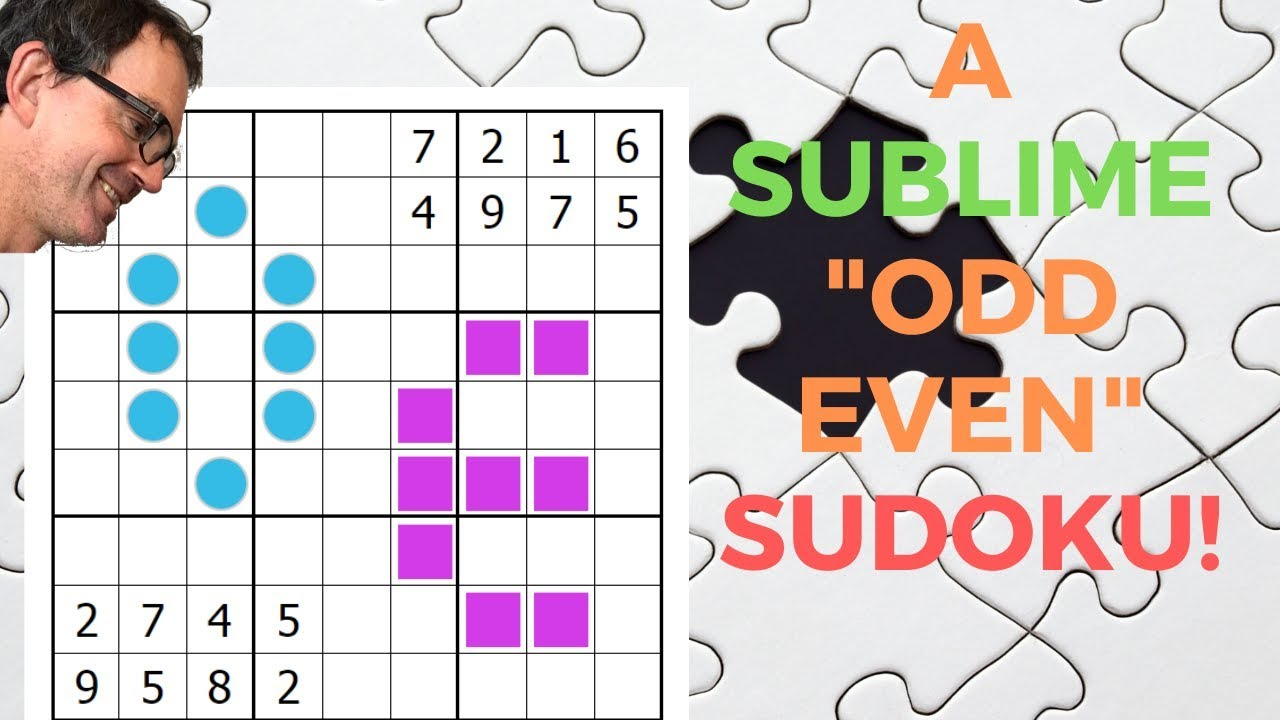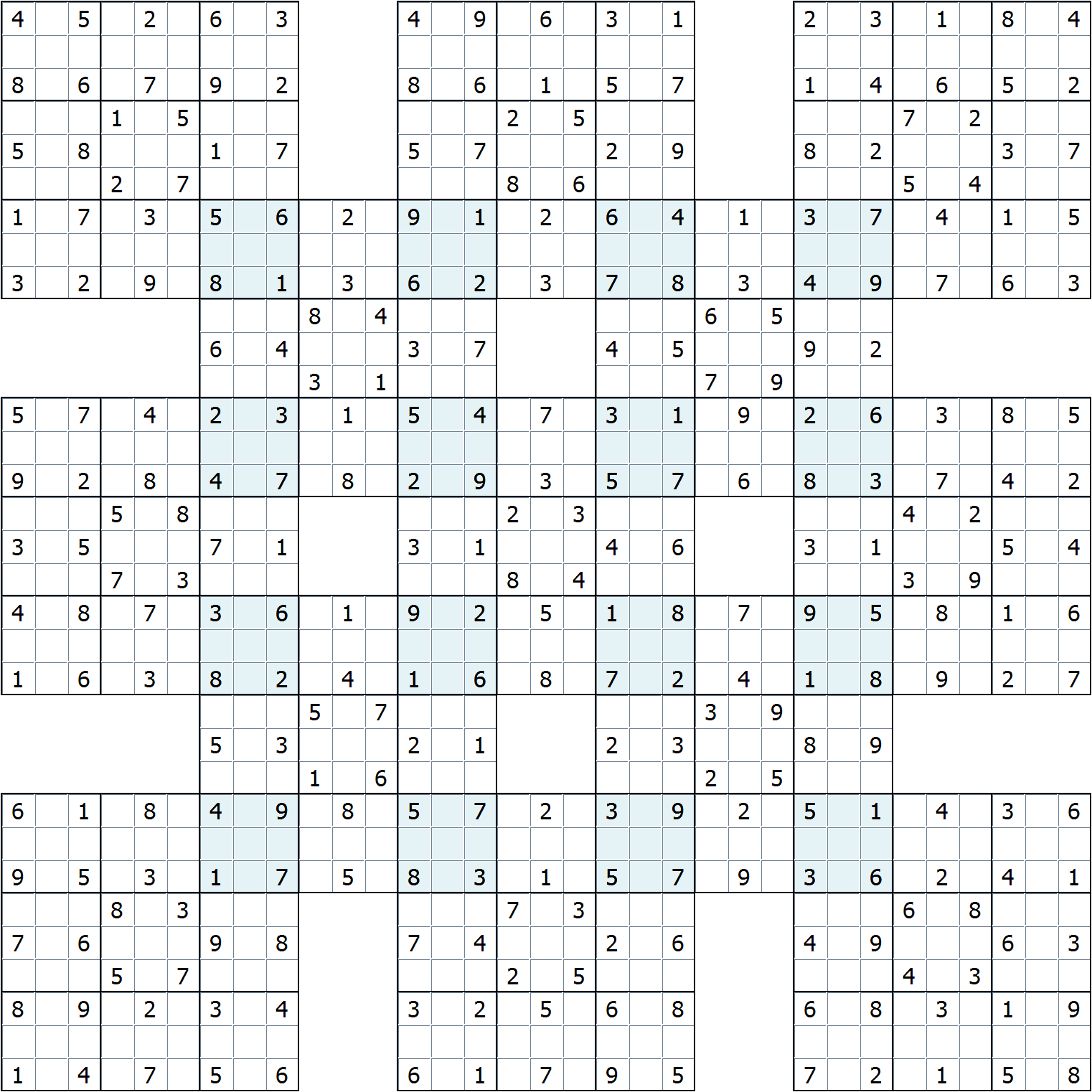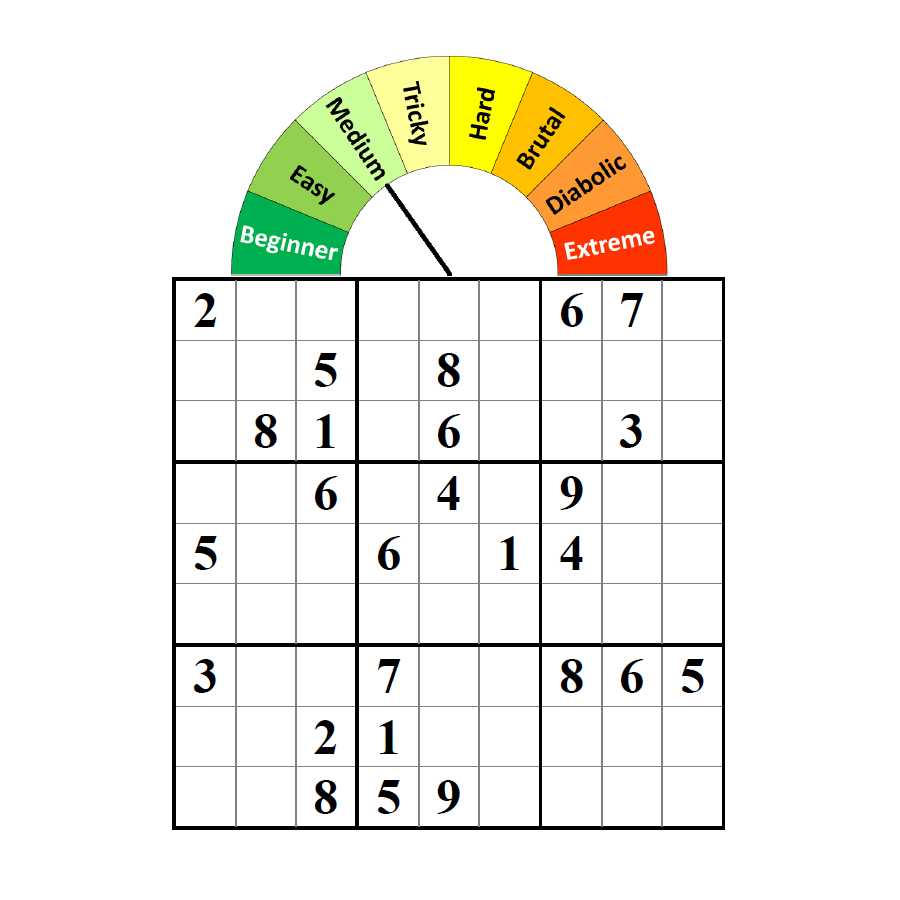Kicking off with squiggly sudoku, this engaging provides a brief overview of the topic. Squiggly sudoku is a unique variation of the traditional sudoku puzzle, with its own set of rules and challenges. Originating from puzzle enthusiasts, this popular game offers a fun and exciting twist for players of all levels.
Let’s dive in and explore the world of squiggly sudoku!
Introduction to Squiggly Sudoku

Squiggly Sudoku is a variant of the popular Sudoku puzzle game that adds an extra layer of complexity and challenge. Unlike traditional Sudoku, which consists of a 9×9 grid divided into nine 3×3 subgrids, Squiggly Sudoku features irregularly shaped subgrids that are interconnected in a squiggly pattern.
This unique layout creates a more intricate puzzle-solving experience.
Origin of Squiggly Sudoku
Squiggly Sudoku was first introduced by Japanese puzzle company Nikoli in the early 2000s. Nikoli is renowned for creating innovative and mind-bending puzzles, and Squiggly Sudoku is one of their most popular creations. Since its inception, Squiggly Sudoku has gained a loyal following among puzzle enthusiasts around the world.
Popularity and Appeal
The irregular subgrid layout of Squiggly Sudoku adds a fresh twist to the traditional Sudoku formula, challenging players to think outside the box and adapt their solving strategies. The squiggly pattern creates unexpected connections between the subgrids, requiring a higher level of logical reasoning and deduction.Squiggly
Sudoku also offers a greater variety of solving paths compared to regular Sudoku, providing puzzle solvers with a unique and engaging experience. The intricate patterns and interconnectedness of the subgrids make every Squiggly Sudoku puzzle a visually appealing work of art.
Interesting Facts and Trivia
- Squiggly Sudoku is sometimes referred to as Jigsaw Sudoku due to its irregular subgrid shapes resembling jigsaw puzzle pieces.
- The irregular subgrid layout of Squiggly Sudoku can also be found in other puzzle variations, such as Samurai Sudoku and Windoku.
- The complexity of Squiggly Sudoku puzzles can vary, with some being relatively easier and others posing a significant challenge even for seasoned Sudoku players.
- Squiggly Sudoku puzzles can be found in various publications, puzzle books, and online platforms dedicated to Sudoku and other logic puzzles.
So, whether you’re a Sudoku enthusiast looking for a new challenge or a puzzle lover seeking a unique and engaging game, Squiggly Sudoku offers an exciting twist on the classic puzzle that is sure to keep you entertained and mentally stimulated.
How to Play Squiggly Sudoku

Squiggly Sudoku is a variation of the classic Sudoku game that adds a twist to the traditional rules. In this version, the grid is divided into irregular shapes instead of the usual 3×3 boxes. The objective of the game remains the same
to fill the grid with numbers from 1 to 9, ensuring that each row, column, and irregular shape contains all the numbers exactly once.
To play Squiggly Sudoku, follow these steps:
Step 1: Understand the Grid
The Squiggly Sudoku grid consists of a 9×9 square divided into irregular shapes. These irregular shapes are formed by thick lines that connect the cells. Each shape should contain all the numbers from 1 to 9 without repetition.
Step 2: Start with Clues
Some cells in the grid will already be filled with numbers, called clues. These clues provide a starting point for solving the puzzle. Take note of the given clues as they will help you determine the possible numbers for the remaining empty cells.
Step 3: Fill in the Numbers
To solve the Squiggly Sudoku puzzle, you need to fill in the empty cells with numbers from 1 to 9. However, you must ensure that each row, column, and irregular shape contains all the numbers exactly once.
Step 4: Use Logic and Deduction
Solving Squiggly Sudoku requires logical thinking and deduction. Look for rows, columns, or irregular shapes that have only a few missing numbers. Use the process of elimination to determine the correct number for each empty cell. Cross off numbers that are already present in the same row, column, or irregular shape.
Step 5: Trial and Error
If you get stuck and cannot find a logical solution, you can resort to trial and error. Select a cell with a limited number of possibilities and try different numbers until you find the correct one. If you reach a point where a number contradicts the rules of Sudoku, backtrack and try a different number.
Additional Rules
In some variations of Squiggly Sudoku, additional rules may apply. These rules can include restrictions on diagonal placement of numbers or special conditions within specific irregular shapes. Always check the specific rules of the puzzle you are playing to ensure you follow the correct guidelines.Now
that you know how to play Squiggly Sudoku, it’s time to put your problem-solving skills to the test and enjoy this challenging and entertaining puzzle game!
Strategies for Solving Squiggly Sudoku

Solving Squiggly Sudoku puzzles can be challenging, but with the right strategies, you can improve your solving skills and tackle even the most difficult puzzles. In this section, we will discuss some tips and techniques used by experienced players to solve Squiggly Sudoku puzzles effectively.
1. Start with the Obvious
When starting a Squiggly Sudoku puzzle, begin by looking for any obvious numbers or patterns. Fill in the numbers that have only one possible placement based on the given clues. This will help you establish a foundation for solving the rest of the puzzle.
2. Focus on One Region at a Time
Instead of trying to solve the entire puzzle at once, it is often helpful to focus on one region at a time. Look for numbers that are missing in a particular region and try to determine their placements by analyzing the surrounding cells.
This approach can simplify the puzzle and make it easier to solve step by step.
3. Use Pencil Marks
Pencil marks are a useful tool in Squiggly Sudoku puzzles. Use a small pencil or pen to make tiny numbers in the corners of empty cells, indicating the possible values that can go in those cells. As you progress through the puzzle, update the pencil marks accordingly.
Pencil marks can help you visualize the potential placements and eliminate possibilities, making the puzzle more manageable.
4. Look for Hidden Patterns
Sometimes, there are hidden patterns in Squiggly Sudoku puzzles that can help you determine the placements of certain numbers. Look for rows, columns, or regions that have limited possibilities for a specific number. By identifying these patterns, you can make informed decisions and fill in more numbers.
5. Use the Process of Elimination
The process of elimination is a powerful strategy in solving Squiggly Sudoku puzzles. Start by looking for cells with only one remaining possibility and fill in those numbers. Then, use the numbers you have placed to eliminate possibilities in the surrounding cells.
By systematically eliminating possibilities, you can narrow down the options and solve the puzzle more efficiently.
6. Practice and Patience
Solving Squiggly Sudoku puzzles requires practice and patience. The more puzzles you solve, the better you will become at recognizing patterns and applying strategies. Don’t get discouraged if you get stuck on a puzzle – take a break, come back to it with a fresh perspective, and keep practicing.
Remember, solving Squiggly Sudoku puzzles is not only about finding the right numbers but also about developing logical thinking and problem-solving skills. With time and practice, you can become a master at solving these intriguing puzzles.
Benefits of Playing Squiggly Sudoku

Playing Squiggly Sudoku offers several cognitive benefits that can enhance problem-solving and critical thinking skills. Research and studies have shown the positive impact of this game on the brain’s functioning and mental abilities.
Improved Cognitive Skills
Playing Squiggly Sudoku requires logical thinking, pattern recognition, and spatial reasoning. By regularly engaging in this game, players can improve their cognitive skills such as memory, attention, and concentration. The constant practice of analyzing and solving puzzles strengthens the neural connections in the brain, leading to improved cognitive function.Squiggly
Sudoku also stimulates the brain’s problem-solving abilities. As players encounter various puzzle layouts and difficulties, they develop strategies to solve them efficiently. This promotes adaptive thinking, where individuals can apply different approaches and techniques to overcome challenges.
Enhanced Critical Thinking
Squiggly Sudoku encourages the development of critical thinking skills. Players are required to analyze the given clues, identify potential number placements, and make logical deductions to complete the grid. This process enhances logical reasoning, deduction, and inference skills, which are essential in everyday life situations.Moreover,
Squiggly Sudoku forces players to think ahead and consider the consequences of their moves. They need to evaluate the possible outcomes and choose the most viable option. This analytical thinking fosters decision-making skills and the ability to assess multiple perspectives.
Research and Studies
Several studies have been conducted to investigate the cognitive benefits of playing Sudoku, including Squiggly Sudoku. A study published in the Journal of Experimental Psychology: General found that regular Sudoku players demonstrated improved cognitive abilities, including working memory and reasoning skills.Another
study published in the Journal of Cognitive Psychology highlighted the positive impact of Sudoku on problem-solving abilities. The researchers observed that individuals who frequently played Sudoku puzzles showed enhanced problem-solving strategies and better performance on other cognitive tasks.These studies suggest that playing Squiggly Sudoku can have a significant impact on cognitive skills and mental abilities.
Regular engagement with this game can contribute to improved problem-solving, critical thinking, and overall cognitive function.
Online Resources for Squiggly Sudoku
Squiggly Sudoku enthusiasts can find a variety of websites and apps that offer Squiggly Sudoku puzzles. These online resources provide a convenient and accessible way to enjoy this challenging puzzle game.
Websites and Apps for Squiggly Sudoku Puzzles
- Sudoku.com: This popular website and app offer a wide range of Sudoku variants, including Squiggly Sudoku. Players can choose from different difficulty levels and enjoy solving puzzles with unique and irregularly shaped regions.
- Daily Sudoku: This website features a daily Squiggly Sudoku puzzle that players can solve for free. It provides a great opportunity for beginners to practice and improve their skills.
- Web Sudoku: With its user-friendly interface and a collection of Squiggly Sudoku puzzles, Web Sudoku is a go-to resource for Sudoku enthusiasts. The website allows players to select the difficulty level and provides helpful hints for those who get stuck.
- Sudoku Kingdom: This website offers a variety of Sudoku puzzles, including Squiggly Sudoku. It provides a timer feature to track solving speed and allows players to compete with others by submitting their completion times.
Advantages of Using Online Resources for Squiggly Sudoku
Online resources for Squiggly Sudoku offer several advantages for both beginners and advanced players. Here are some benefits of using these resources:
- Accessibility: Online resources allow players to access Squiggly Sudoku puzzles anytime and anywhere as long as they have an internet connection. This makes it convenient for players to practice and enjoy the game at their own pace.
- Variety: Websites and apps that offer Squiggly Sudoku puzzles often provide a wide range of difficulty levels and puzzle variations. This allows players to choose puzzles according to their skill level and preferences, ensuring a challenging and engaging experience.
- Instant Feedback: Online resources often provide features such as automatic error checking and highlighting of incorrect entries. This instant feedback helps players identify and correct mistakes, enhancing their problem-solving skills and efficiency.
- Timer and Competitions: Some online platforms allow players to track their solving time and compete with others by submitting their completion times. This adds a competitive element to the game and motivates players to improve their solving speed.
Recommendations for Squiggly Sudoku Puzzles
For beginners or advanced players looking for Squiggly Sudoku puzzles, Sudoku.com and Web Sudoku are highly recommended. These platforms offer a user-friendly interface, a wide selection of puzzle difficulties, and additional features to enhance the solving experience.
Squiggly Sudoku vs. Traditional Sudoku

Squiggly Sudoku and traditional Sudoku are both popular puzzle games that are enjoyed by people of all ages. While they share similarities, there are also some key differences between the two variants.
Differences between Squiggly Sudoku and Traditional Sudoku
Squiggly Sudoku, also known as Jigsaw Sudoku, introduces a new twist to the traditional game by incorporating irregularly shaped regions instead of the standard 3×3 boxes. This adds an extra level of complexity and challenge to the puzzle, as players need to consider the shape and layout of each region when placing the numbers.Traditional
Sudoku, on the other hand, follows a strict 9×9 grid with 3×3 boxes. The puzzle is divided into rows, columns, and boxes, and players must fill in the empty cells with the numbers 1 to 9, ensuring that no number repeats in any row, column, or box.
Pros and Cons of Squiggly Sudoku
One of the advantages of Squiggly Sudoku is that it offers a fresh and unique experience for Sudoku enthusiasts. The irregularly shaped regions make the puzzle more visually appealing and provide an additional layer of complexity. It requires players to think outside the box and approach the game with a different strategy.However,
the increased complexity of Squiggly Sudoku can also be a disadvantage for some players. The irregular shapes may initially confuse beginners, making it more difficult to solve the puzzle. It can take time to get accustomed to the new layout and develop effective solving strategies.
Pros and Cons of Traditional Sudoku, Squiggly sudoku
Traditional Sudoku has the advantage of being more straightforward and easier to understand, especially for beginners. The fixed 3×3 box structure provides a clear framework for solving the puzzle, making it easier to identify patterns and logically deduce the placement of numbers.On
the downside, traditional Sudoku can become repetitive for experienced players who are looking for a fresh challenge. The standard layout may not offer the same level of excitement and variety as Squiggly Sudoku.
Personal Preference
Personal preferences may vary when it comes to choosing between Squiggly Sudoku and traditional Sudoku. Some players enjoy the added challenge and visual appeal of Squiggly Sudoku, while others prefer the simplicity and familiarity of traditional Sudoku. Ultimately, it boils down to individual preferences and the level of difficulty one is seeking in a Sudoku puzzle.Both
variants have their own unique charm and provide hours of brain-teasing fun. Whether you prefer the irregular shapes of Squiggly Sudoku or the structured layout of traditional Sudoku, both games offer a delightful puzzle-solving experience that can be enjoyed by all.
Essential FAQs
What is squiggly sudoku?
Squiggly sudoku is a variation of the traditional sudoku puzzle. Instead of a regular grid, it features irregularly shaped regions that add an extra level of challenge to the game.
How do you play squiggly sudoku?
To play squiggly sudoku, fill in the grid with numbers from 1 to 9, making sure that each row, column, and irregularly shaped region contains all the numbers exactly once.
Are there any additional rules for squiggly sudoku?
The rules of squiggly sudoku are similar to traditional sudoku, but with the added challenge of irregularly shaped regions. Apart from that, there are no specific additional rules.
What are the benefits of playing squiggly sudoku?
Playing squiggly sudoku can improve cognitive skills such as problem-solving, critical thinking, and logical reasoning. It also provides a fun and challenging activity that helps relax and train the mind.
Where can I find squiggly sudoku puzzles online?
There are several websites and apps that offer squiggly sudoku puzzles. Some popular options include Sudoku.com, Sudoku Kingdom, and Sudoku Solver. These platforms provide a wide range of difficulty levels and variations to cater to different players’ preferences.